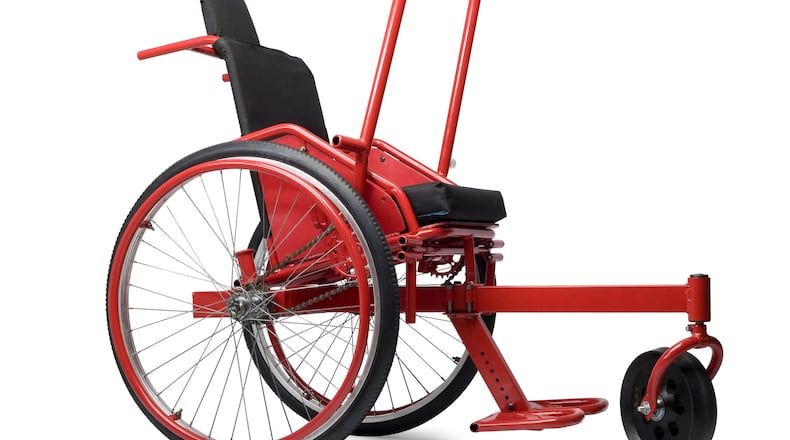ART REVIEW
“Beautiful Users” and “On You: Wearing Technology”
Through Oct. 2. Noon-6 p.m. Tuesdays-Wednesdays, Fridays and Sundays; noon-8 p.m. Thursdays; 10 a.m.-6 p.m. Saturdays. $10, adults; $8, seniors, military, educators; $5, children ages 6-17 and college students; free for children 5 and under and members. Museum of Design Atlanta, 1315 Peachtree St. N.E., Atlanta. 404-979-6455, www.museumofdesign.org.
Bottom line: Design by academics, industrial designers and lay-people for real-life uses makes for a democratic, inspiring demonstration of design’s possibilities.
Design is often thought of as a means for creating products that people will want to buy.
But the Museum of Design Atlanta show “Beautiful Users” surveys a different approach to design: how it can look squarely at the potential users of a product and factor them into that product’s creation.
Take, for instance, the case of designer and MIT professor Amos Winter’s Leveraged Freedom Chair, featured in “Beautiful Users.” Wheelchairs are meant to give access to people whose disability impedes it. But most wheelchairs assume they will be used to navigate paved city streets and spaces with some degree of built-in accessibility.
But in reality, there are disabled people who live in rural places in the developing world, who have to navigate unpaved, uneven roads and difficult terrain. The Leveraged Freedom Chair, made of cheap and widely available bicycle parts, takes that difficult topography into account and with its locomotion provided by two hand-levers that power the chair, boasts a design that is also inexpensive to operate.
An early advocate of the user-centric approach to design featured at MODA is midcentury designer Henry Dreyfuss, a man who put the human factor at the center of his design practice. Considered the father of industrial design, through direct observation Dreyfuss came up with innovations like the lightweight, pretty 1959 “Princess” phone, which allowed users to rest a phone on their torso as they talked, a design innovation his team picked up while observing teenagers whiling away the hours in their bedrooms with a phone perched on their chest.
Not only considering the needs of the user, “Beautiful Users,” which originated at Cooper Hewitt, Smithsonian Design Museum in New York, also looks at how users have “hacked” existing products. It’s one of the most entertaining, and also inspiring, segments of the show because their inventions show the ingenuity of ordinary people in adapting design to fit their needs.
There is an entire design subgenre, for instance, of consumers who take existing Ikea products and parts and create new designs from them. In an example featured in “Beautiful Users,” a simple Ikea stool is transformed into a hip, high-end looking shelf-coat rack combo, the Frosta Z Coat Rack by Andreas Bhend. The sheer ingenuity of ordinary people’s imaginations and the use of design to both experiment and solve problems are also evident in the use of 3-D printing technology, which democratizes design, allowing creators to share a workable solution to a problem that anyone with access to a 3-D printer can execute.
That same vanguard, ingenuous approach to design crops up in a concurrent exhibition, curated by Georgia Institute of Technology’s Clint Zeagler. “On You: Wearing Technology” often shares a similarly inventive, quirky approach to design, in part by showing how a group of wearable design enthusiast “makers” like Tech’s Thad Starner (also a co-curator of the show) and Vassar College’s Greg Priest-Dorman created idiosyncratic, personal hacks that would eventually grow into real-world applications of wearable technology.
Here the beautiful users are often the guinea pig professors including Starner road-testing devices like wearable computer glasses that over time have morphed into Google Glass.
There is something deliciously inspirational, maybe a little silly, too, in these inventions created to fit personal, but also professional needs. Like looking at a stone wheel and an automobile in the same room, these devices also show the rapid progress of technology since the 1990s and how quickly design ideas jump from the avant-garde to the ubiquitous.
About the Author
Keep Reading
The Latest
Featured


